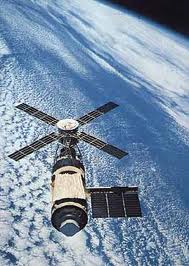Thirty-three years ago on July 11 America's Skylab returned to earth in pieces littering the Indian Ocean and Australia. First launched in 1974, Skylab was America's first space station and hosted three sets of 3-man U.S. space crews during its operation, with the station itself having been occupied a total of 171 days. The station may have lasted longer had the new NASA Space Shuttle program been further along to repair the station and adjust its orbit.
What did Skylab accomplish? According to a NASA paper on the program, the primary impact was highlighting the value of a manned operation:
While the program unquestionably yielded valuable scientific information,
its greatest value came from its demonstration of the importance of the
human element in the space program. As John Disher, NASA Director of Advanced
Programs in the Office of Space Transportation Systems, would later note,
Skylab
"turned around many people who thought men in space were a hindrance rather
than a help." Echoing this sentiment,
Program Director William Schneider stated that
Skylab had shown
that, regarding the space program, "the limit is only our resolve, not
the ability of men to work, and not our technical knowledge."
We need more of that resolve as we look to future manned missions.
